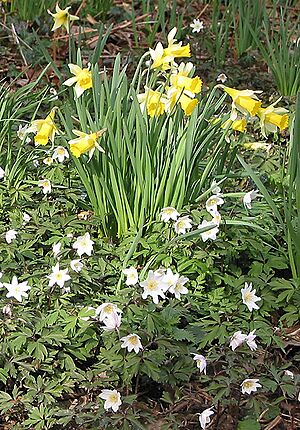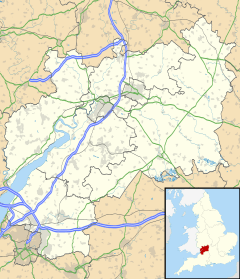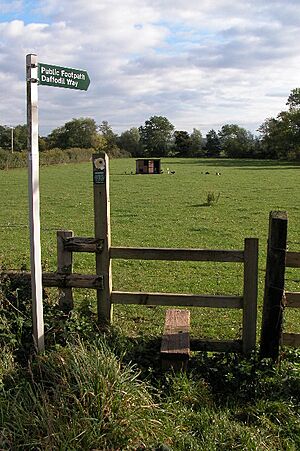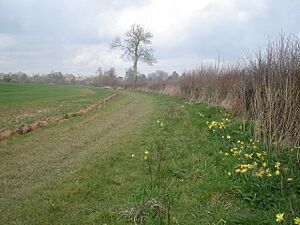Dymock Woods SSSI facts for kids
| Site of Special Scientific Interest | |
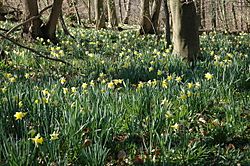
Wild daffodils at Dymock
|
|
| Area of Search | Gloucestershire |
|---|---|
| Grid reference | SO684288, SO692290, SO697283 |
| Coordinates | 51°57′25″N 2°27′18″W / 51.957°N 2.455°W |
| Interest | Biological |
| Area | Area: 53 hectare |
| Notification | 1990 |
Dymock Woods is a special natural area in Gloucestershire, England. It covers about 53 hectares, which is like 130 football fields! This place was named a Site of Special Scientific Interest (SSSI) in 1990. This means it's a very important spot for wildlife and nature.
The woods are also known as a Key Wildlife Site. Dymock Woods is split into three main parts. One of these parts is a nature reserve called Betty Daw's Wood, managed by the Gloucestershire Wildlife Trust.
Contents
Discover Dymock Woods
What Makes Dymock Woods Special?
Dymock Woods is located a few miles southwest of the village of Dymock. It includes areas like Dymock Wood, Daw's Coppice, Betty Daw's Wood, and Colonel's Grove. This site has some of the best mature sessile oak trees left in the wider Dymock Forest.
These oak trees have grown into a tall, dense forest. The woods are also a key home for many insects, especially butterflies and moths. The soil here is a bit acidic and drains well, formed from old red sandstone. Small streams cut through this rock, showing even older rocks underneath.
Trees of the Forest
In the acidic parts of the woodland, you'll mostly find sessile oak trees. You'll also see silver birch and wild cherry trees. The wild service tree is common throughout the area.
Underneath the taller trees, there's a layer of smaller plants called the understorey. This mostly includes hazel, hawthorn, and holly. Near the streams, the woods are mainly sessile oak and alder. You might also spot small-leaved lime and ash trees. The understorey here is mostly hazel, with some wild privet and dogwood.
Beautiful Ground Plants
The ground in Dymock Woods is often covered with brambles and bracken. You'll also find typical woodland flowers like bluebells, wood anemones, and yellow archangel. Other plants like heather, bilberry, and common cow-wheat also grow here.
Along the streams, the ground is mostly covered with dog's mercury. You can also find woodruff and sanicle.
A very special sight in early spring is the wild daffodil. These beautiful yellow flowers are a big feature of the woods. Other less common plants here include bitter-vetch, tutsan, and lily-of-the-valley.
Amazing Insects
Dymock Forest is super important for butterflies and moths. You can find the pearl-bordered fritillary and wood white butterflies here. The rare white admiral butterfly also lives in these woods.
Other interesting moths recorded include the great oak beauty and satin lutestring. Some other rare moths are found because they rely on specific woodland plants.
Betty Daw's Wood
About Betty Daw's Wood
Betty Daw's Wood is located two miles northeast of Newent. This part of the woods has never been planted with conifer trees. It has always remained a 'semi-natural' woodland. It became owned by the Crown during the First World War. Since 1919, the Forestry Commission has managed it.
Since 1967, this wood, including an area called Colonel's Grove, has been a nature reserve. It's cared for by the Gloucestershire Wildlife Trust. The wood was once managed by cutting trees back to the stump (called coppicing) to make charcoal. By the 1850s, it had grown into a tall forest with sessile oak trees.
Trees in Betty Daw's Wood
The large sessile oak trees in Betty Daw's Wood are from around 1850. The oaks in Colonel's Grove were cut down in 1920. This part of the wood was then replanted with ash and beech trees.
You can also find wild cherry and wild service trees here. There are also small-leaved lime trees. The shrub layer, which is the lower level of plants, is mostly hazel that has been coppiced.
Wonderful Wildflowers
Betty Daw's Wood is famous for its amazing display of wild daffodils. They bloom beautifully in early spring. The wood is part of the Wild Daffodil Trail. This trail offers two walks where you can see many wild daffodils.
The walks also include smaller nature reserves. These are places like Gwen and Vera's Fields, Ketford Bank, and Vell Mill Daffodil Meadow. The ground plants in the wood are very varied. They include wood anemones, bitter-vetch, wood-sorrel, bluebells, and primroses.
Nest Box Scheme for Birds
A special project to help birds started in 1964. The North Gloucestershire Naturalists' Society set up nest boxes. This is one of the longest-running projects like this in Gloucestershire.
Records show that birds like the pied flycatcher, spotted flycatcher, nuthatch, wren, treecreeper, and marsh tit have used these boxes. Other birds that breed here include the dunnock, song thrush, and garden warbler. You might even hear Nightingales singing in the wood.
Mammals and Insects
The hazel coppice areas are a great home for the common dormouse. These small, cute mammals love to live there.
Woodland butterflies found here include the white admiral, wood white, and silver-washed fritillary.
Protecting the Woods
The Forestry Commission and the Gloucestershire Wildlife Trust work together to protect Dymock Woods. They do things like making paths and open areas wider. They also do coppicing, plant new trees, and clear out ponds. They carefully thin out some of the sessile oak, ash, and beech trees to keep the forest healthy.


